
个人主页~
list(上)~
list
四、模拟实现1、list.h(1)关于整个list的搭建①节点②迭代器③接口 (2)自定义类型实例化 2、test.cpp(1)test1(2)test2 五、额外小知识
四、模拟实现
1、list.h
#pragma once#include <iostream>namespace little_monster{template<class T>struct list_node{T _data;list_node<T>* _prev;list_node<T>* _next;list_node(const T& x = T()):_data(x),_prev(nullptr),_next(nullptr){}};template<class T,class Ref,class Ptr>struct __list_iterator{typedef list_node<T> Node;typedef __list_iterator<T, Ref, Ptr> self;Node* _node;__list_iterator(Node* n):_node(n){}self& operator++(){_node = _node->_next;return *this;}self& operator--(){_node = _node->_prev;return *this;}self& operator++(int){self tmp(*this);_node = _node->_next;return tmp;}self& operator--(int){self tmp(*this);_node = _node->_prev;return tmp;}Ref operator*(){return _node->_data;}Ptr operator->(){return &_node->_data;}bool operator!=(const self& s){return _node != s._node;}bool operator==(const self& s){return _node == s._node;}};template<class T>class list{typedef list_node<T> Node;public:typedef __list_iterator<T, T&, T*> iterator;typedef __list_iterator<T, const T&, const T*> const_iterator;iterator begin(){return iterator(_head->_next);}iterator end(){return iterator(_head);}const_iterator begin() const{return const_iterator(_head->_next);}const_iterator end() const{return const_iterator(_head);}void Init_empty(){_head = new Node;_head->_next = _head;_head->_prev = _head;_size = 0;}list(){Init_empty();}list(const list<T>& lt){Init_empty();for (auto e : lt){push_back(e);}}void swap(list<T>& lt){std::swap(_head, lt._head);std::swap(_size, lt._size);}list<int>& operator=(list<int> lt){swap(lt);return *this;}~list(){clear();delete _head;_head = nullptr;_size = 0;}void clear(){iterator it = begin();while (it != end()){it = erase(it);}}void push_back(const T& x){insert(end(), x);}void pop_back(){erase(--end());}void push_front(const T& x){insert(begin(), x);}void pop_front(){erase(begin());}iterator insert(iterator pos, const T& x){Node* cur = pos._node;Node* newnode = new Node(x);Node* prev = cur->_prev;prev->_next = newnode;newnode->_prev = prev;newnode->_next = cur;cur->_prev = newnode;++_size;return iterator(newnode);}iterator erase(iterator pos){Node* cur = pos._node;Node* prev = cur->_prev;Node* next = cur->_next;delete cur;prev->_next = next;next->_prev = prev;--_size;return iterator(next);}size_t size(){return _size;}private:Node* _head;size_t _size;};}(1)关于整个list的搭建
①节点
节点是一个struct封装的类,由数据、指向前一个位置的指针、指向后一个位置的指针、构造函数共同构成,创建的是一个独立的节点,初始化指针都为空
②迭代器
迭代器是一个struct封装的类,由构造函数、自增自减、解引用、判断相等接口构成,其中Ptr接受指针,Ref接受引用
其中operator* 和operator->之前没有见过,operator* 很简单,返回的是该节点的值data,也就是解引用的作用,然后operator->为了增加代码的可读性,其实是省略了一个->,当A->_data时,其实是A.operator->()->_data,然后这里的A.operator->()返回的是A的指针,然后通过间接访问符->访问_data
其中,有关于迭代器的类型
在list中,迭代器的三个模版参数分别为T、T&、T*,也就是说这个迭代器有该类型,该类型的引用和该类型的指针三个模版参数,这里就是将有关于迭代器的功能全部封装在里边,因为在以前的学习中,包括string和vector,它们的迭代器都是原生态指针,这里对于迭代器的要求更加复杂,因为对于string和vector来说,它们的存储空间是连续的,而list是不连续的
③接口
接口就是常规的接口,包括构造、拷贝构造、析构、增删查改函数,增删查改的接口直接复用的insert和erase,对于构造函数和拷贝构造函数我们封装了一个Init_empty函数,用来生成头结点
(2)自定义类型实例化
struct AA{AA(int a1 = 0, int a2 = 0):_a1(a1), _a2(a2){}int _a1;int _a2;};void test3(){list<AA> lt;lt.push_back(AA(1, 1));lt.push_back(AA(2, 2));lt.push_back(AA(3, 3));auto it = lt.begin();while (it != lt.end()){std::cout << (*it)._a1<<" "<<(*it)._a2 << std::endl;std::cout << it->_a1 << " " << it->_a2 << std::endl;std::cout << it.operator->()->_a1 << " " << it.operator->()->_a1 << std::endl;++it;}std::cout << std::endl;}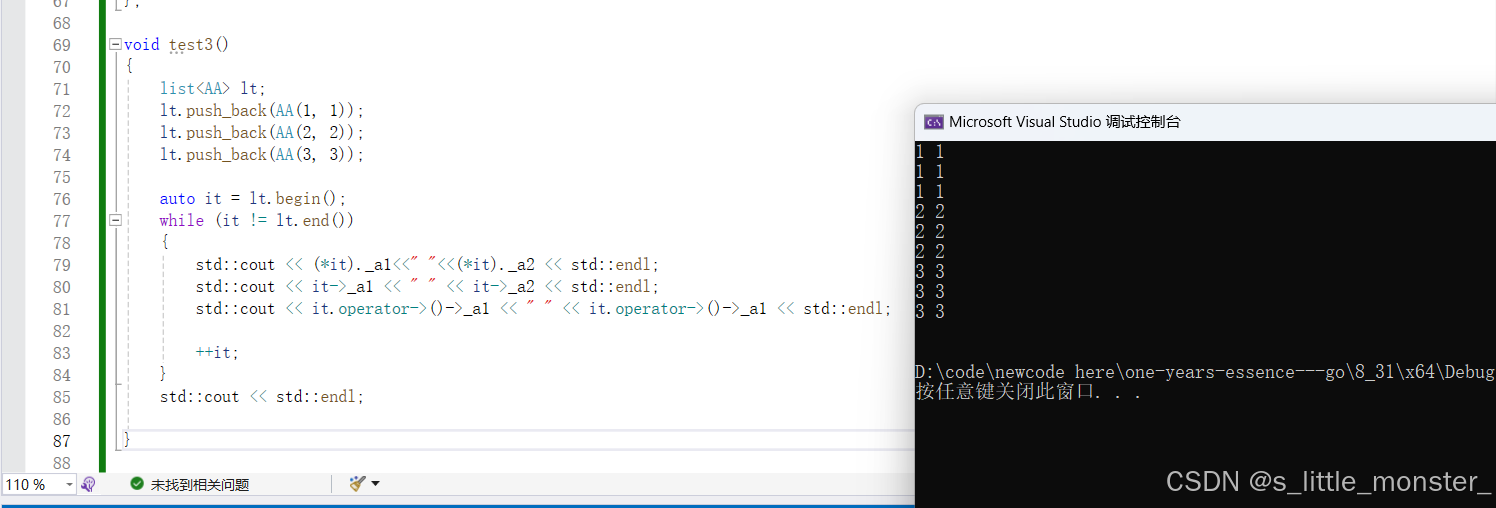
如果是自定义类型的话,访问其中的元素就需要访问操作符来进行访问,这里有三种方式进行访问,都是通过被封装的迭代器进行的
2、test.cpp
(1)test1
测试尾插构造以及拷贝构造
void test1(){list<int> lt1;lt1.push_back(1);lt1.push_back(2);lt1.push_back(3);lt1.push_back(4);lt1.push_back(5);list<int> lt2(lt1);for (auto e : lt1){std::cout << e << " ";}std::cout << std::endl;for (auto e : lt2){std::cout << e << " ";}std::cout << std::endl;}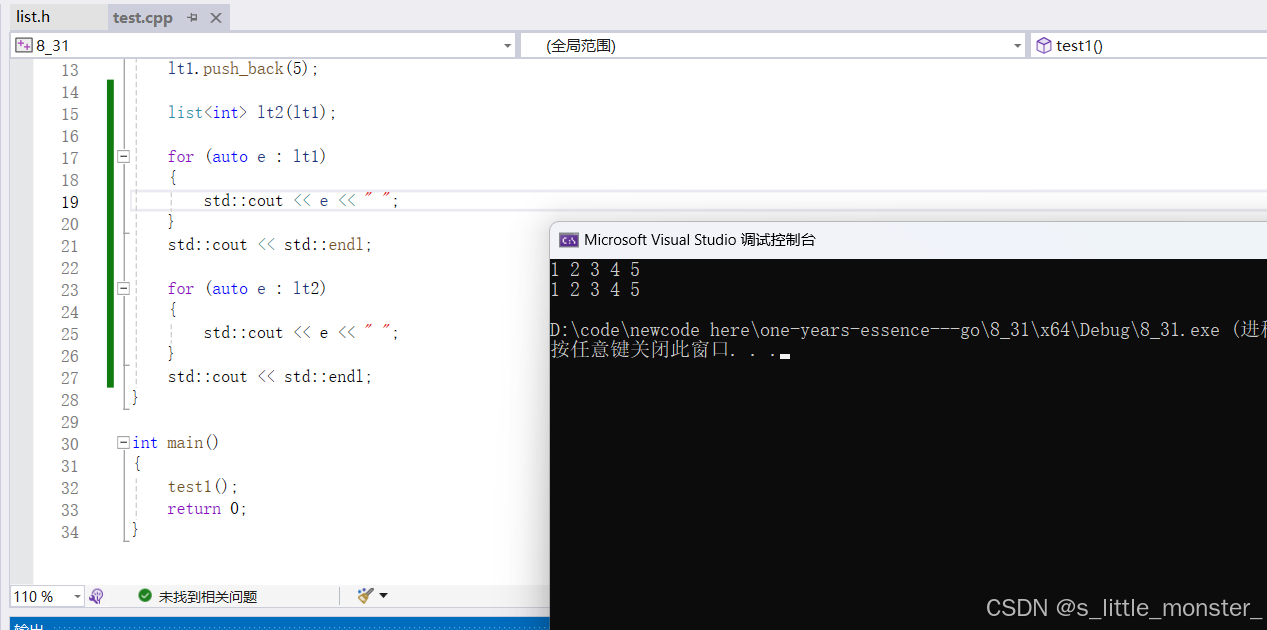
(2)test2
void test2(){list<int> lt1;lt1.push_back(1);lt1.push_back(2);lt1.push_back(3);lt1.push_back(4);lt1.push_back(5);lt1.insert(++lt1.begin(), 6);lt1.insert(--lt1.end(), 7);for (auto e : lt1){std::cout << e << " ";}std::cout << std::endl;lt1.erase(++lt1.begin());lt1.erase(--lt1.end());for (auto e : lt1){std::cout << e << " ";}std::cout << std::endl;}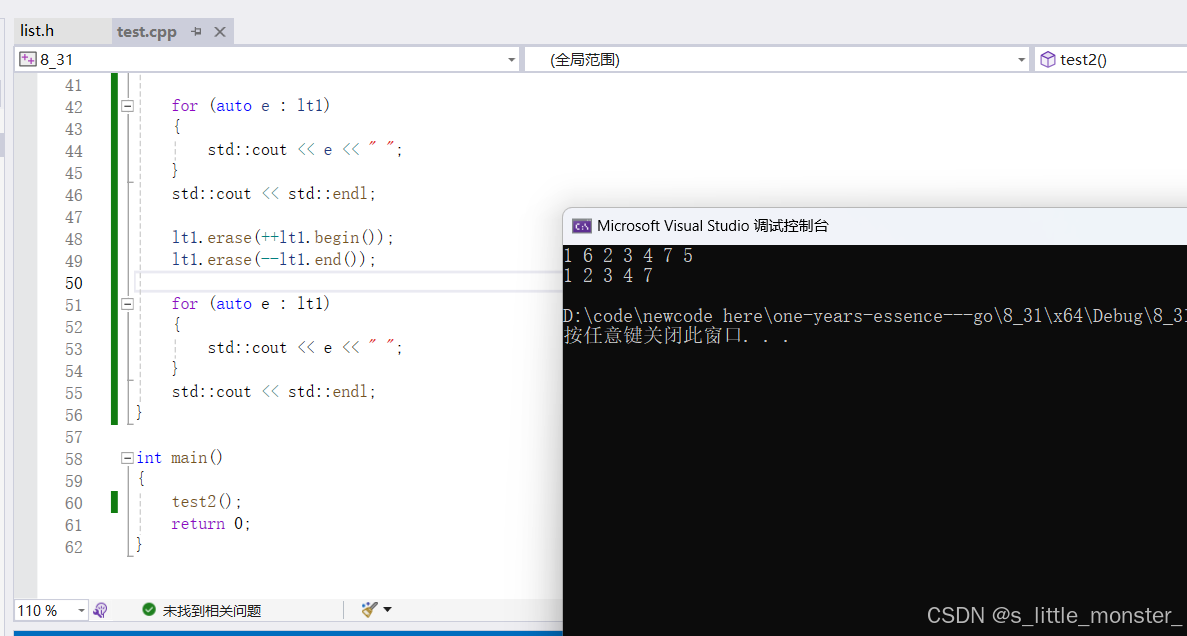
这里解释一下,insert是插入指定位置前面一个元素,也就是说6插入到了2前面,7插入到了5前面
erase是删除指定位置的元素,也就是第二个元素以及头结点前一个元素分别是6和5
五、额外小知识
有关于内置类型也会调用构造函数这件事
void test4(){int* p = new int;*p = 1; //int* p = new int(1); //上面和这句结果是相同的,过程不同,一个是在构造后进行赋值,一个是初始化列表赋初值 AA* ptr = new AA;ptr->_a1 = 1;}前面的文章提到过这件事,因为它套用了模版,模版当然也要兼容内置类型,所以内置类型在构造时可以使用类似自定义类型构造的形式,这样也会类似于调用模版函数
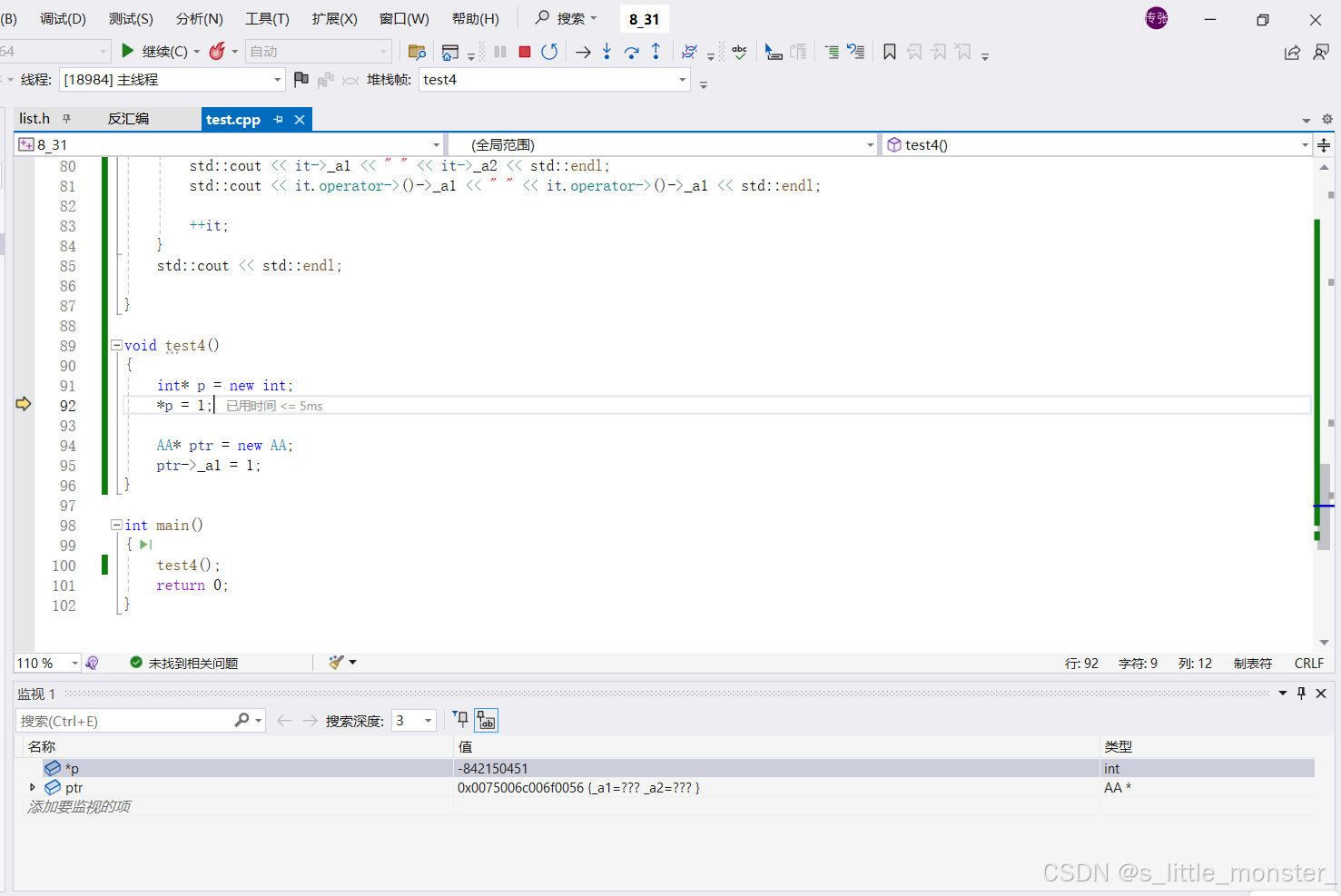
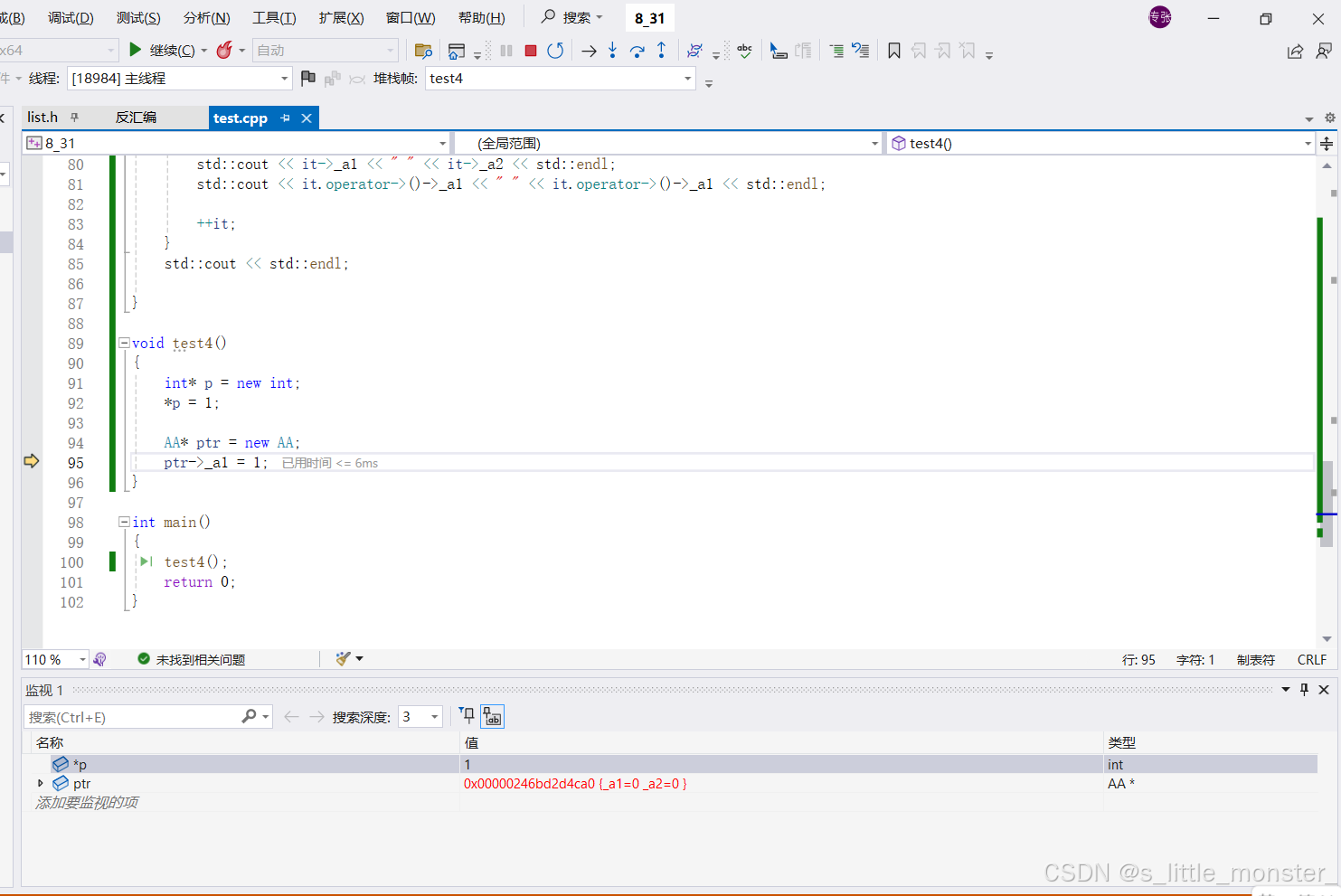
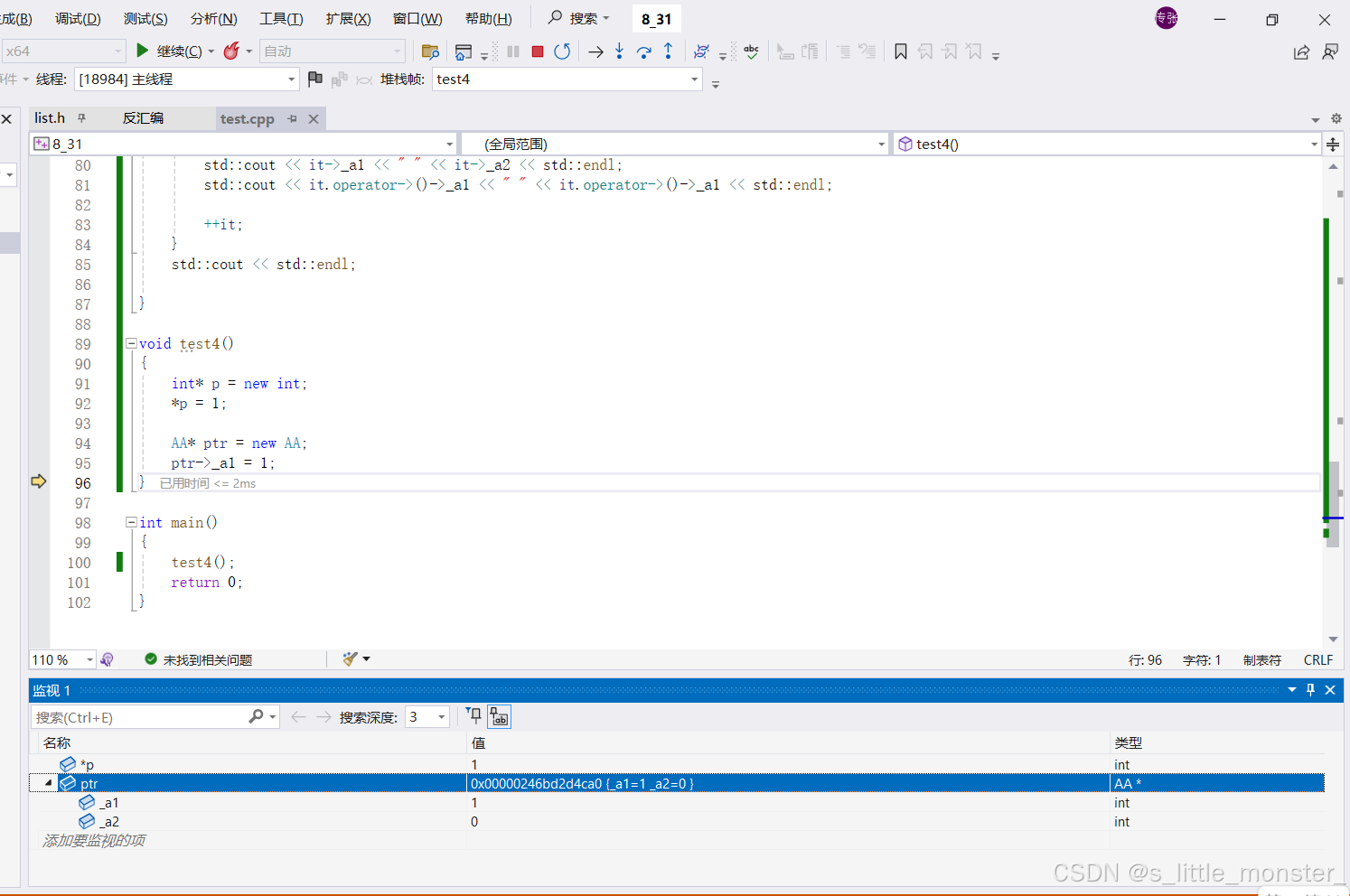
今日分享到这里~
